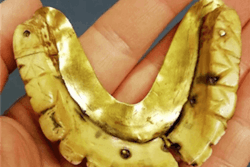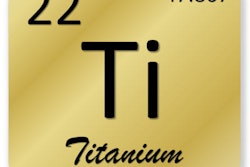
Once literally the gold standard for dental restorations, the precious metal has largely been replaced by ceramics as the material of choice for most dentists. The soaring cost of gold combined with the development of ceramic materials has led to a decline in gold's allure in dentistry.
Gold has been used in dentistry for centuries because it doesn't corrode and is biocompatible.
 Douglas M. Schulz, DDS.
Douglas M. Schulz, DDS."I was a huge gold dentist until about 1995," Douglas M. Schulz, DDS, a private practitioner in Overland Park, KS, told DrBicuspid.com. "We talk about the gold standard in dentistry, and it really was the material by which every other restoration was judged because it was such a good material."
In the old days, gold that was used for restorations was 87% pure, but now gold alloys can contain as little as 30% gold, Dr. Schulz said.
"It was a beautiful gold to use for inlays, onlays, and partial coverage restorations," he recalled. "If you knew how to work gold really well, you could do gold in a tooth and hardly ever see it."
Now gold is often alloyed with other metals such as copper to make it more economical.
"They use 30% to 40% gold, which means the other 70% is ground up car bumpers or other metals," Dr. Schulz said.
Gold loses its allure
Bennett Napier, executive director of the National Association of Dental Laboratories, said full cast gold crowns now make up less than 10% of the U.S. market, mostly because the cost has soared to more than $1,200 per ounce.
"The trend is definitely changing, and the price of gold is certainly one of the key factors," he told DrBicuspid.com.
For example, Dr. Schulz explained that a zirconia crown, which he said is as strong as metal, would cost as little as $4 for the materials and a few dollars more for the milling machine.
"If I did a gold inlay today, when the price of gold is $1,200 per ounce, the lab cost could be $200 to 400 just for the gold, while it costs $30 max for ceramics or composites," he said.
Dr. Schulz now only uses gold if patients ask for it. "Now I have the ability to put zirconia crowns on second molars, and keep it almost as thin as a gold crown, and it looks like a tooth and it'll act like a tooth," he explained.
In addition to the skyrocketing price of gold, Dr. Schulz cited a couple of factors that led to the declining use of gold in dentistry.
The growing popularity of cosmetic dentistry, especially the widespread demand for teeth whitening, helped speed gold's decline, he said.
"You see people who now have teeth that are whiter than white, toilet-bowl white," Dr. Schulz said. "We joke about that, but I get patients who come in, and you give them the whitest white that you can possibly get a lab to make, and it's still not white enough!"
Ads showing people with dazzling white teeth and television shows depicting dramatic makeovers in the personal appearance of contestants, particularly with cosmetic dental care, have affected the public's perception of good looks.
"Suddenly we had all these ads and TV programs doing extreme makeovers on people, and there's always a dental component because you can't change a patient without changing their smile," Dr. Schulz said. "So life changed because of smiles."
Having a gold tooth was once a status symbol, particularly among some Asian and Hispanic cultures. But as time went by, people began wanting crowns with a more natural appearance, Dr. Schulz said.
Do patients still ask for gold restorations? "Absolutely, but it's few and far between now, and it's usually older patients who grew up seeing gold teeth," Dr. Schulz said. "They're used to the gold and they have really good gold in their mouth, but it's not a popular choice in dentistry anymore."
Growth of ceramics
There has been more of a shift to porcelain-fused metals for restorations, Napier said.
"The increase in ceramics and the ability to use digital CAD/CAD milling are the biggest factors in the transition from full gold to all ceramics," Napier said. "We are seeing double-digit growth in all ceramics."
Dr. Schulz cited the versatility, durability, and convenience of ceramics among the reasons why more dentists prefer them for restorations.
"When you bond ceramics to a tooth, you actually strengthen the tooth," he explained. "When we're about to mill out ceramic restorations chairside and bond them chairside in a single visit, that changed the whole system of how we're doing things."
Gold won't fracture, but it can fracture teeth if used improperly, Dr. Schulz said.
"Gold was probably the longest-lasting material that we had," he said. "But now that ceramics have come into dentistry, especially the newer generations of ceramics, you can be as conservative with ceramics as we were with gold without the fractures."
Dr. Schulz predicts that ceramics will prove to be a superior, longer-lasting material than gold for restorations.
"If the dentist follows the guidelines and takes time to prep properly and do the kind of dentistry he should do when using ceramics, I'm really betting that the longevity, the plaque accumulation, and everything else would be very similar to gold," he concluded.
But when dentists say they're putting in permanent restorations, patients often have unrealistic expectations, Dr. Schulz said.
"If we ever say to a patient, 'This is a permanent restoration that's going to last forever,' you don't know what their hygiene is, how they bite, do they clench or grind, do they suck on lemons, do they get in fistfights?" he said. "Nothing lasts a lifetime except death and taxes."



















